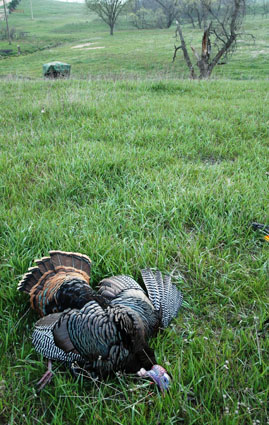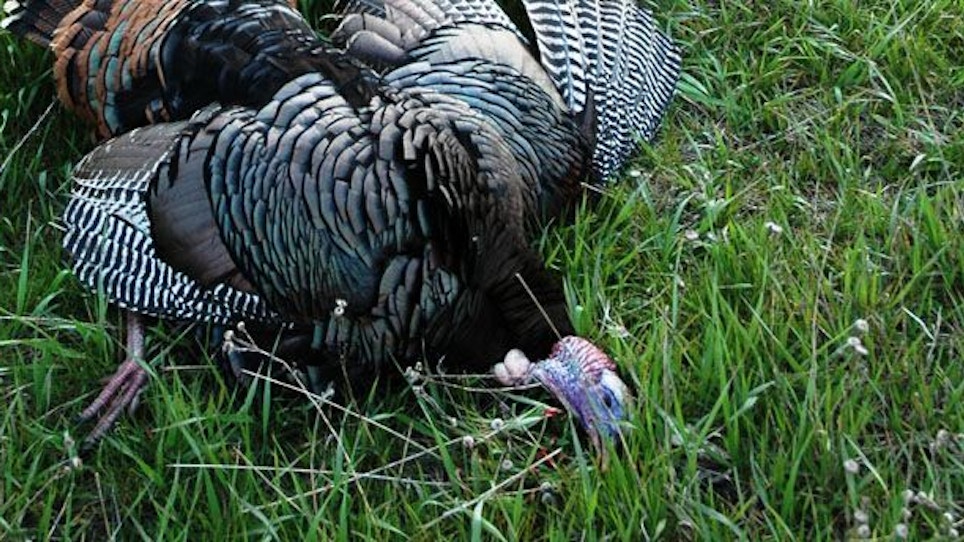 The Author’s South Dakota gobbler with blind in background. |
Few things in life are as inspiring as a good spring turkey hunt. There’s the exhilarating chase after distant gobbles, the thrill of a coming-on tom, the beauty of just being outdoors at the very best of times – sunrise on balmy days in May.
Turkey hunting is bound in beauty even here, in the South Dakota plains, some people’s idea of desolation. As I made my way back to my turkey camp on the Moreau River one day last May, it struck me what I find so alluring about this land. It’s not so much what the country offers, but what it lacks that I like. No noise of civilization, no other hunters, no bugs, no impenetrable thickets. I even like the lack of trees, which makes the Western landscape and “big sky” so striking.
The Moreau River is truly ideal habitat, not just for turkeys, but for turkey hunting. The mix of crops, pasture and natural herbs provides plenty of sustenance, even with a lack of the staple turkey food: acorns. The broad valley, stretching between high bluffs marking a mammoth ancient river course, grows willows, cottonwoods, and a variety of prairie grasses and legumes. Turkeys travel the corridors of cover nurtured by the moist river runs. Their only other option is to wander out into the arid plains, and they avoid that, especially with the gunners around. So they stick near the river and flock there early and late in the day because it’s one of the few places with big roosting trees. That tendency to concentrate makes birds here easier to pinpoint than those living in expansive Eastern forests.
I meandered along the river trying to analyze sign and read habitat until I came upon a nice grove of cottonwoods. Knowing birds might spot me from a half-mile if I wasn’t careful, I picked my way cautiously along a sparse line of cover until I came to a fallen tree in a meadow. I eased out 20 yards and set up a decoy, then scooted well back into the thick shadows of the decaying treetop, setting up my bow in easy reach.
With my friction box and mouth call, I yelped and cackled loudly, trying to reach out across the open expanses to the eardrums of some eager tom. No response. I got comfortable and called for a few seconds every five to 10 minutes until an hour passed.
Then I heard it. Or thought I did. When you’re listening hard for gobbles, it’s easy to imagine you heard one. Woodpeckers, other birds, even the wind can sound like a gobble on the edge of perception.
But then it came again and I knew it was a gobble. Across the Moreau. I leapt to my feet and ran for the river, grabbing the decoy on my way by, knowing it was crucial to get my calls within earshot of the tom while he was still there and still hot. After running the bank for a ways, I found a place that looked least likely to envelop me in quicksand, and mucked across.
The turned-on tom seemed to be on the perimeter of a willow thicket. When I knew I was within reaching distance of a turkey’s acute hearing, I looked for cover in the pasture. I decided on a plum thicket, where I could quickly cut some shooting lanes, hunker in, and have a good chance of drawing undetected on a gobbler as he approached a decoy set 20 yards out in the open.
I hit the box call, hard, and braced myself for an explosive gobble. Nothing. I called again and again, trying not to sound overanxious, though I was. Still nothing. After an hour, I knew the gobbler was gone.
That afternoon I found the owner of the ranch where I’d seen a small turkey flock and got permission to hunt there. It was a beautiful spot where a creek fed into the main river. It was a perfect crossing. I expected some action – at least to hear some gobbling in the prime roosting area across the river that evening. Nothing.
A quarter-mile past the spot where I’d heard the gobbler the day before, I found a high grassy grove of big cottonwoods. Twenty paces toward the river from a windfall, I set up two decoys, a jake and a hen in “mounting” position. I set up my Double Bull blind and was happy with the setup: Plenty of visibility for the decoys to do their job, and converging riverbottom and windbreak tree strips to funnel traveling turkeys to me.
My yelps and cackles pummeled the prairie off and on for an hour. Then another. I started to wonder whether my “sitting” strategy was so wise after all, looking for an excuse to get up and walk around.
Then one of my cackles was cut off and stuffed back down my throat by an earth-shaking gobble-obble-obble!
I jolted upright. I held back awhile, then slipped out a couple of quiet clucks. The gobbler thundered. My pulse raced and breath became ragged as they always do when I know the gobbler’s coming in.
After a few minutes I clucked once, and when the tom exploded, it seemed he was just on the other side of the ancient cottonwood I sat against. When I heard “drumming” and the brushing of wing tips on the ground, I realized he was.
Fighting the urge to peek, I finally glimpsed the valley bigmouth as he strutted by. Three yards from me, the kaleidoscopic red, white and blue of his head was breathtaking. I turned to stone and squinted hard to avoid blinking. The tom popped in and out of strut twice before he reached the fake hen, but as he got there, he seemed alerted. He either spotted me or realized his beau was a fraud, and started angling warily away. The arrow leapt, sizzled through the arid air, and smacked home, knocking the big bird into a sprawling ball of loose feathers. He let out a gobble of surprise and dashed for the river. The shaft pointed straight out of his breast.
I hoisted my gobbler and we headed upriver toward camp. It was a heavy burden and a long hike, but somehow I didn’t mind the work. And the desolate Moreau River turkey country seemed more beautiful than ever.






